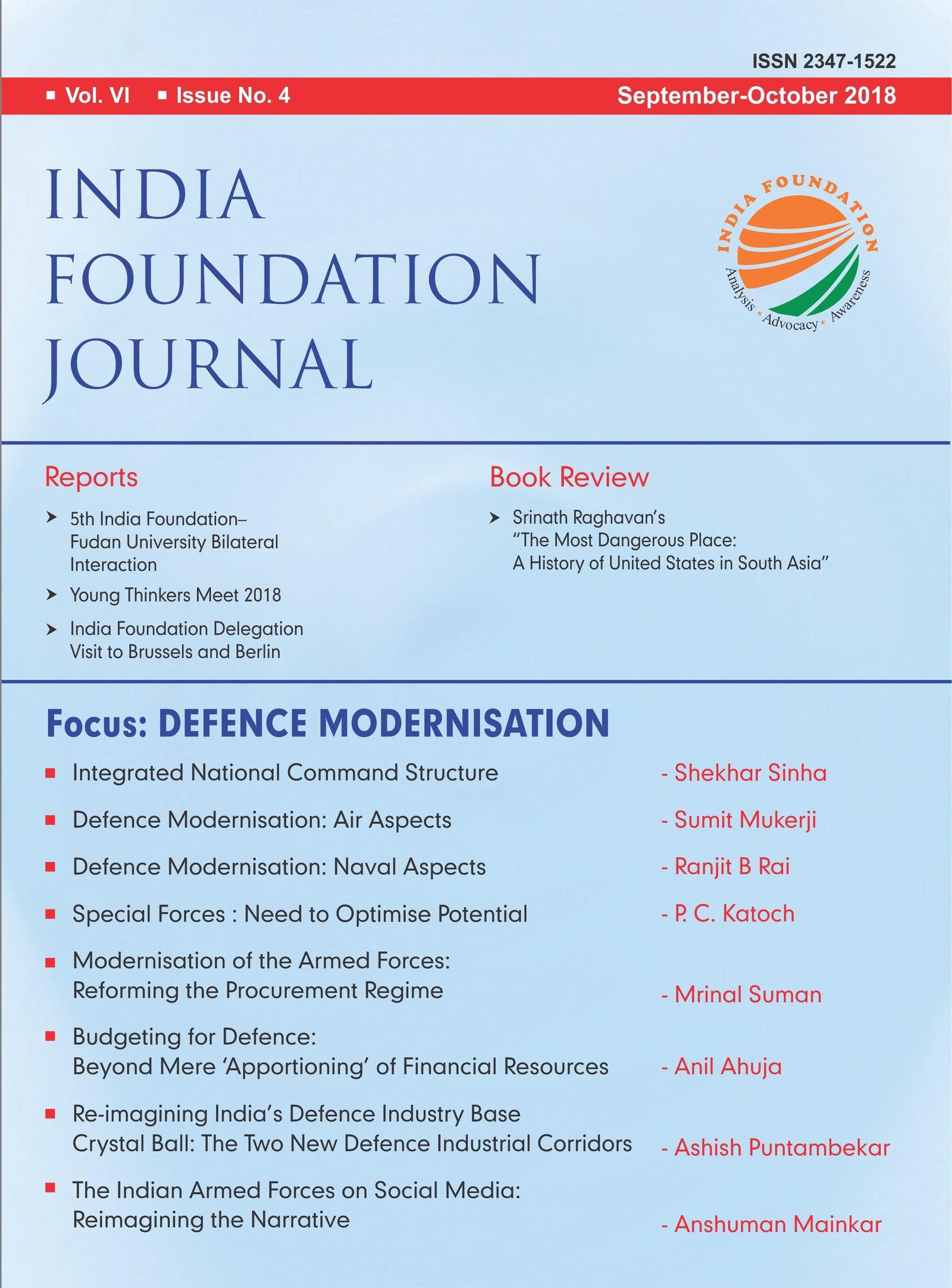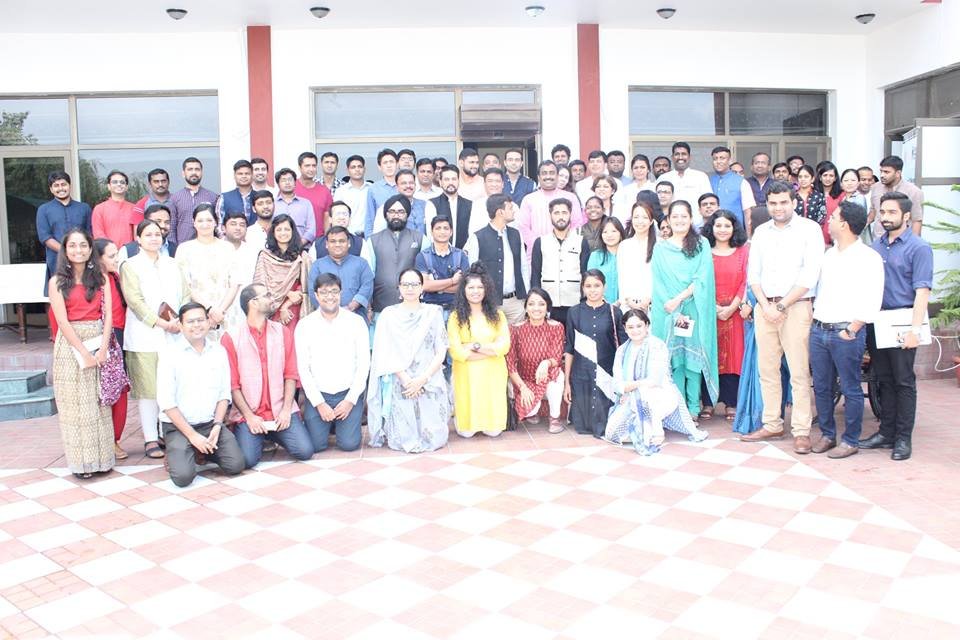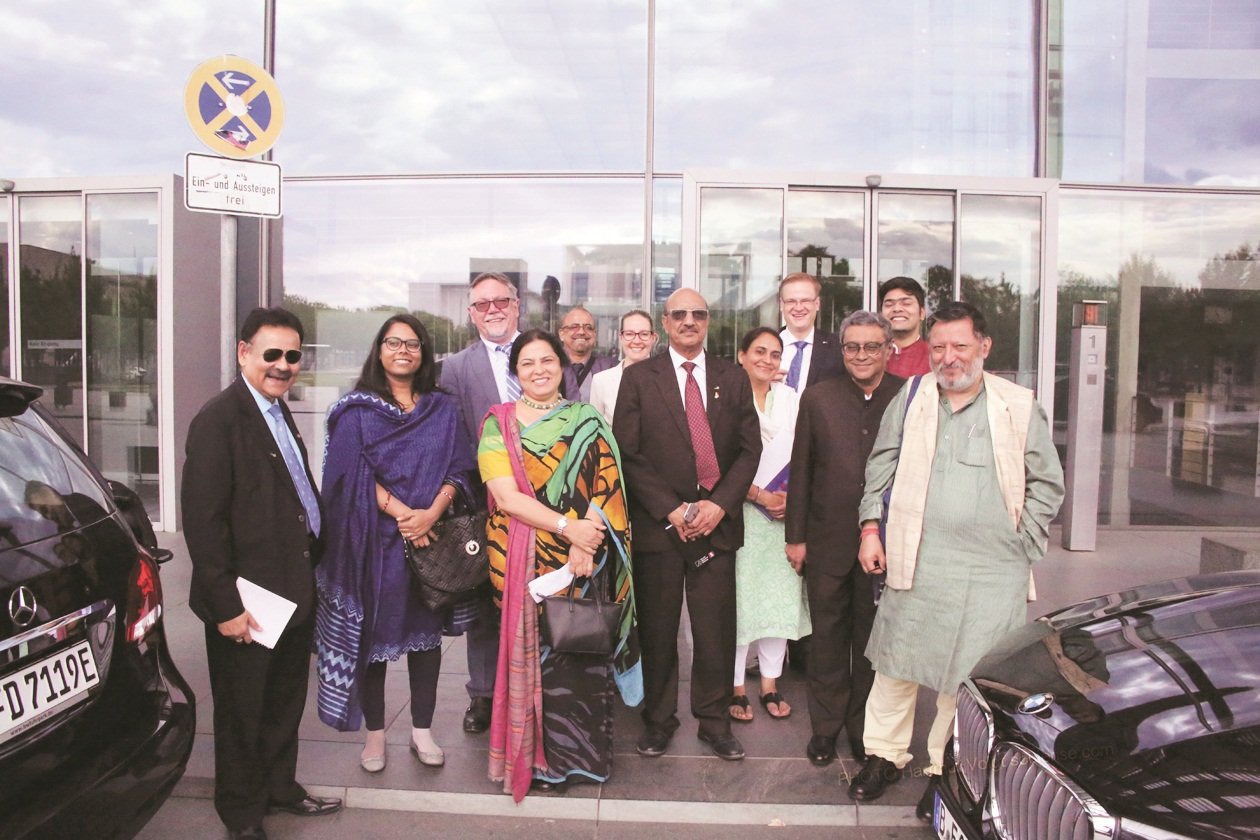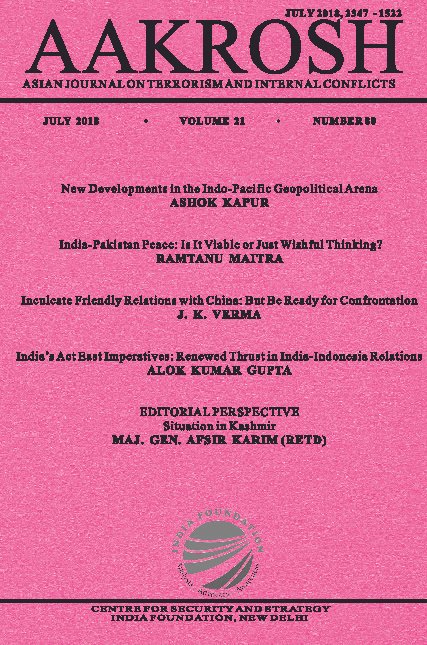The spectrum of conflict has four segments viz; nuclear, biological and chemical; conventional, sub-conventional, and; cyberspace. The conventional wars are getting rare because costs of conventional wars have risen phenomenally both in terms of finances and human lives. Therefore, a quiet but significant change has occurred in warfare, in that, while earlier it was only conventionally weaker nations that waged asymmetric wars employing irregular forces against a conventionally superior adversary, now even powerful nations have turned to this form of warfare. Global players have changed largely from ‘boots on ground’ to ‘proxy boots on ground’. There is no denying that as conventional wars between states have receded, irregular forces have emerged with greater strategic importance over not only conventional but even nuclear forces. Irregular forces having carved for themselves such prominent space in the spectrum of conflict, this in turn has provided increasing scope for employment of Special Forces individually, as well as ‘in conjunction’ proxy forces. To this end, special operations conducted by Special Forces need not be exclusive only, though these are not talked about because of their clandestine nature and for avoiding specific blame.
Global Trends and Irregular War
Extracts of a UK study titled ‘Global Strategic Trend 2040’ relevant to this article are: one, radicalization, extremism, and terrorism will continue to generate threats – many operating trans-nationally, requiring ongoing cooperation and multinational interoperability between security services to provide an effective response; two, potential adversaries, both state and non-state, will leverage high-technology niche capabilities and employ innovative concepts of operation; three, incidence of armed conflict is likely to increase underpinned by widespread inequality – population increases, resource scarcity, adverse effects of climate change and increased importance of ideology; four, future conflict will remain unpredictable and violent – technology will remain important but people are likely to provide the asymmetric edge; five, cyberspace will be widely exploited by all types of actors, and; six, changing balance of power is likely to deter military intervention by major powers outside their spheres of influence; when intervention becomes unavoidable, actors will seek to distance themselves by use of proxy forces, cyber-attack, as well as covert and clandestine methods.1
The above amplifies wars or conflicts that are not really defined, are ambiguous with no defined borders, and may not have defined actors to fight against. Adversary can be state, non-state, state-sponsored non-state, or a mix of all. For example, the Afghan government is battling the Afghan Taliban as well as proxies of Pakistan, in addition to non-state forces like Haqqani Network, Islamic State Khorasn and al-Qaeda, even as the latter two may have underhand links with Pakistan’s ISI. Similarly, in the Israrel-Hezbollah conflict and in Syria, the main adversaries are non-state entities within the state system. That is why irregular forces are in play in West Asia, Ukraine, and South Asia. Consequently, even the US and NATO have been battling irregular forces. These non-state actors can act as proxies for countries but have independent agendas as well. They can be trans-regional, transcending air, land, space, cyberspace and electromagnetic, even using weapons of mass disturbance / destruction. Transnational nature of threats and involvement of state actors in using subconventional conflicts have increased the complexity and technology empowers terrorists to cause severe damage through cyber, financial, kinetic attacks. The nature of irregular war makes population an important centre of gravity. Therefore, intelligent investments in population at multiple levels including psychological, can provide dividends in this type of conflict. This is also relevant to areas of strategic interests abroad where continuous perception building is of vital importance – not just presence of Indian Diaspora. There is heightened need for intelligence and deniable covert capabilities that ensure deniability of action for achieving strategic aims, both of which require Special Forces employment.
The Chinese concept of unrestricted warfare states that if mankind has no choice but to engage in war, it can no longer be carried out in the ways with which we are familiar; referring to terrorist attack on US embassy, gas attacks on Tokyo subway and havoc wreaked by Morris Jr. on the Internet, degree of destruction not being second to war, representing semi-warfare, quasi-warfare, sub-warfare – embryonic forms of another kind of warfare.2. Significantly, it emphasises most modern military force cannot control public clamour, and cannot deal with an opponent who does things in an unconventional manner.3 On the battlefields of the future, the digitised forces may very possibly be like a great cook who is good at cooking lobsters sprinkled with butter, when faced with guerrillas who resolutely gnaw corncobs, they can only sigh in despair. It also suggested developing weapons that ‘fit the fight’.4 As far back as 2001, speaking at the Regional Conference on Security held in Bangladesh both Pakistani speakers (Shirin Mazari and Lt Gen Javed Hassan) openly advocated low intensity conflict, guerilla warfare, indirect intervention, psychological warfare, terrorism and subversion as a manner of tactics short of direct all out military confrontation.5 US-NATO has been suffering casualties in Afghanistan because of Pakistani support to Afghan Taliban and Pakistan-based terrorist organisation, yet substantive financial aid to Pakistan has only been affected recently, other than drone attacks, but no other physical action against terrorist sanctuaries in Pakistani side of the Afghan-Pakistan border. This is because of Pakistan’s strategic importance to the US as also the CIA-ISI links.
In this context, it is also relevant to note what abovementioned study ‘Global Strategic Trend 2040’ says with respect to military intervention, which India should relate to its strategic partners in the event of conflict with China-Pakistan, when intervention becomes unavoidable, actors will seek to distance themselves by use of proxy forces, cyber-attack, as well as covert and clandestine methods. We should therefore be clear that such conflicts will essentially be fought by us, and us alone. The US branding some mullahs ‘global terrorists’, or even so-called bans by UN or Pakistani government on terrorist organisations really don’t mean anything with the anti-India terrorist infrastructure fully active.
Threats India Faces
The Indian Army has been talking of a two-and-half front war for some time and this half front getting with China-Pakistan surreptitiously fanning insurgencies in India. Pakistan’s proxy war on India needs little elaboration. ISI is engaged in reviving Khalistani movement against India. China provides tacit support to Pakistan’s anti-India jihad and has been supporting Indian Maoists, besides providing ULFA training, arms and sanctuary on Chinese soil. Arms and communication equipment are being pumped into India, particularly to Maoists and the PLA of Manipur. Chinese intelligence was behind the NSCN (K) abrogating its 13 year old ceasefire with India. In 2015, Chinese intelligence orchestrated establishment of the United Liberation Front of West, South, East Asia (ULFWSEA) in Myanmar, combining nine major militant groups of northeast including the NSCN (K) and ULFA.6 With this, China has the handle to create instability in our northeast while it claims entire Arunachal Pradesh. The China-Pakistan collusive terrorist threat is also manifesting through Maldives getting rapidly radicalised by Pakistani proxies. Chinese support to Pakistan is becoming stronger with her strategic lodgment in Gilgit-Baltistan with a PLA base in Skardu, China-Pak Economic Corridor (CPEC) and Gwadar as Chinese naval base. In addition, a joint China-Pakistan military base is under development at Jiwani in the Gulf of Oman and another PLA base planned in FATA.
China sponsored Nepalese Maoists are linked with our Maoists and China is pumping weapons through Kachen rebels in Myanmar to insurgents in Manipur and Indian Maoists. In Myanmar, China has created her deadliest proxy in the 10,000 strong United Wa State Army (UWSA), arming them with machine guns, rocket launchers, anti-tank weapons, shoulder fired AD missiles, armoured troop carrying vehicles and even missile fitted helicopters.7 Hambantota in Sri Lanka leased to China for 99 years is coming up as joint China-Sri Lanka naval base. Gadhoo island in Maldives is being developed as strategic support base by China, and China has similar plans for a facility in Seychelles.8 The Chinese base in Djibouti is fully functional from where China has even fired lasers at US pilots. Chinese engagement with Bangladesh, Nepal and Sri Lanka has been rising exponentially.9 Beijing’s broad-based military cooperation agreement with Dhaka, Bangladesh’s first military accord with any country apparently has following objectives: to bring Bangladesh into China’s strategic orbit; to gain naval and commercial access to strategically important Chittagong port connecting Bangladesh with Myanmar; and to secure a doorway to India’s vulnerable North-East.
India has been confronting illegal immigration from Bangladesh and Myanmar. These, particularly the Rohingyas, pose serious security threat to India, given that the Arakan Rohingya Salvation Army (ARSA) is headed by a Pakistani national and the organisation is supported and funded by Saudi Arabia and Pakistan’s ISI and the LeT.10 China’s involvement in the Rohingya issue and its nexus with Pakistan also gives it a hold in using ARSA as proxy. Internally, India is dealing with multiple insurgencies, Maoists being the biggest. Maoists need special attention keeping in mind Pakistan’s ISI had arranged training in IEDs / explosive for a core group of Maoists with the LTTE.11 As early as 2005, Maoists were found using ammunition with Pakistan Ordnance Factory markings.12 STRATFOR warned in 2009 that ISI was forging alliance with the Maoists and media reports of SIMI training 500 Maoists cadres in 2008.13 There are 40 banned organizations, many others have potential for active terrorism; Popular Front of India (PFI) being one example. PFI was traced after al-Qaeda and LeT footprints were discovered in Kerala during 2005.14 Five PFI cadres were caught in Kupwara few years back attempting to cross over to POK. Evidence of PFI cadres in combat uniform undergoing arms training in jungles of Kerala exists. There is also the problem of radicalisation by ISIS, Indian Mujahiddeen etc. These insurgencies provide an asymmetric battlefield for our enemies to exploit, which they are doing.
Combined strategic objectives of China-Pakistan vis-à-vis India are likely to be as follows: keep India confined to South Asia through asymmetric and hybrid means and capture as much Indian territory as possible; expand joint power asymmetry and indirect posturing in POK-Pakistan to force India give up designs to capture POK; hedge India’s economic rise while ensuring availability of Indian markets to China; shrink India’s Strategic Space in South Asia / IOR through bringing smaller states in China’s orbit; undermine India’s role in Afghanistan; dominate Arabian Sea indirectly challenging India at sea; perpetuate two front collusive hybrid threat dilemma including destabilising India from within; and scuttle India’s entry into Nuclear Supplier Group (NSG) and United Nations Security Council (UNSC) till Pakistan is also admitted.
Strategic Asymmetry
In the India-China-Pakistan conundrum, China already has full spectrum conflict capability. India and Pakistan are taking initial steps in cyberspace but what should be a matter of serious concern in India is that while both China and Pakistan possess advance sub conventional capabilities, India is lagging way behind in this sphere. This is a strategic asymmetry considering that sub conventional war is and will continue to be the order of the day. Irregular forces can hardly be deterred through conventional power but somehow India does not appear to acknowledge this. Operation ‘Parakaram’ post the terrorist attack on the Indian Parliament should have driven this point home, as also that direct actions like surgical strikes only have tactical value, but of little deterrence value at strategic level. Actually, India has failed to create deterrence against irregular forces relying mainly on diplomacy. In this context, we also suffer from lack of strategic intelligence and perception building through engagements at multiple levels even in our immediate neighbourhood; reverses in our ‘Neighbous First’ policy cannot be blamed only on Chinese investment muscle. Not only do we have asymmetries in the space, cyberspace and electromagnetic domains with respect to China, we also face unconventional warfare including terrorism. China-Pakistan are working towards creating instability in our hinterland. India lacks credible deterrent against irregular/unconventional warfare to break the China-Pakistan anti-India nexus.
Employment of Special Forces by Foreign Armies
The US-NATO, Russia, Israel, China and Pakistan are using their Special Forces pro-actively not only for direct actions but to serve as eyes behind enemy lines, keep areas of strategic interests under surveillance, perception building, creating an environment in own interest, controlling the fault-lines of adversaries, building partner capabilities. US Special Forces are presently deployed in some 186 countries and are active in West Asia, Afghanistan and Ukraine. Russian Spetsnaz similarly are active in West Asia, Ukraine and Central Asia. American historian William Blum stated in 2014, “Since 1945, the US has tried to overthrow more than 50 governments, many of them democratically elected; grossly interfered in elections in 30 countries; bombed the civilian populations of 30 countries; used chemical and biological weapons; and attempted to assassinate foreign leaders. In many cases Britain has been a collaborator.” 15 The contribution of the United States Special Forces (USSF) in all this is obvious.
Chinese Special Forces are trained in rapid reaction combat in a limited regional war under high-tech conditions, commando operations, counter-terrorism, and intelligence gathering all integral to Chinese concept of ‘Unrestricted Warfare’ mentioned earlier. China deploys them, mixed with PLA troops, in all its development projects abroad, tasked with information support operations, strategic surveillance, training, arming and advising dissident / terrorist / insurgent groups in target countries, perception management and evacuation of Chinese public in case of emergency. It may be recalled that Chinese intelligence infiltration operations into Nepal and Burma under Mao Zhedong led to the rise of Maoist insurgencies, aim in Nepal being to install a regime that was not friendly to India and US.16 Chinese nationals were apprehended with fake Indian documents, on a mission to meet Naga rebels. China had developed links with the Taliban even before the US invasion of Afghanistan, and was providing training to them in China. By abetting insurgencies China keeps her adversaries destabilised, suppressed and forced to look inwards.
Pakistan’s ISI is linked with some 15 regional and international terrorist organisations including ISIS, al-Qaeda, Taliban, LeT, JeM, LeJ, HM, Sipah-e-Sahiba, IM, SIMI, Muslim militant groups in our northeast and PFI. Asim Umar, AQIS chief of South Asia and Pakistani national, has called on Indian Muslims to undertake ‘lone wolf’ attacks. The Myanmar-based ARSA too is supported by ISI and LeT. Pakistan Army’s bible is the book ‘The Quranic Concept of War’ published in 1979, that justifies terrorism, urging jihad as collective responsibility of the Muslim ummah, and is not restricted to soldiers. SSG Pakistani army regulars and Mujahids are covertly assisting Afghan Taliban in large numbers past several years.17In 2007, a Taliban commander who turned out to be a Pakistani SSG officer was
killed in Helmand Province of Afghanistan by the British SAS.18
Special Forces and Special Operations
The term Special Forces is often misunderstood. The word “Special” should be sufficient to understand that such forces are to be primarily employed on strategic tasks beyond national borders. There is also tendency to mix them with airborne troops who are trained for air induction but on landing perform infantry tasks including holding ground, even though behind enemy lines. Stephen P Cohen wrote in his book, ‘The Idea of Pakistan’, “The task of Special Forces is the proxy application of force at low and precisely calculated levels, the objective being to achieve some political effect, not a battlefield victory.”19 This basic is ignored in India perhaps because we still don’t have a National Security Strategy, leave aside defining a national level Concept for Employment of Special Forces. Ignorance and inability to grasp the strategic environment, its setting and compulsion under which such forces are employed are evident. Special Forces should be central to asymmetric responses, which does not imply operating in large numbers always since such response does not automatically imply physical attack. A physical attack is only the extreme and potentially most dangerous expression of asymmetric warfare. The key lies in achieving strategic objectives through application of modest resources with the essential psychological element.
We have failed to acknowledge that tasks of Special Forces have widened to include controlling fault-lines of the adversaries, shaping the environment in favour of own country, building partner capabilities and the like. Special Forces do not create insurgencies but optimise prevailing dissent and instability in enemy territory. Employing Special Forces strategically is a different ball game from using them as super infantry in counter insurgency within India and an odd trans-border direct action raid. Special operations are ‘special’ or unconventional operations undertaken by dedicated Special Forces using unconventional methods and resources, performed independently of or in conjunction with conventional military operations. Such operations are usually conducted at operational and strategic levels in a low-profile manner that aims to achieve the advantages of speed, surprise, and violence of action against an unsuspecting target.
Optimising Indian Special Forces
The Naresh Chandra Committee had recommended in 2012 setting up a Special Forces Command. This should have been established forthwith, however, during the Unified Commanders’ Conference in July 2017, Defence Secretary announced Special Operations Division will “soon” become reality.20 What India needs is a two-tiered special operations capability: first tier under the highest political authority (the Prime Minister) for politico-military missions at strategic level and as deterrent against non-traditional threats (could be termed National Operations Division – NOD), and; second tier as force multipliers for military operations beyond capabilities of regular military troops under the CDS / Chiefs of Staff Committee (could be termed Special Operations Division – SOD).
The first tier (NOD) based on a ‘cutting edge’ numbering about two-three battalions needs to be established, with the nucleus taken from existing Special Forces. Special Forces Teams (SFTs) of the NOD individually may comprise 25-50 or more personnel depending on the country / region and its relative importance in terms of national security objectives. They should have institutionalised access to integrated intelligence, varied insertion and extraction capability and adequate support elements. It is important to remember that special operations are typically carried out with limited numbers of highly trained personnel that are adaptable, self-reliant and able to operate in all environments, and able to use unconventional combat skills and equipment, and special operations are usually implemented through specific, tailored intelligence. The PM would need an advisory cell comprising Special Forces and R&AW officers tasked with: evolving a national doctrine and strategy for employment of Special Forces, oversee their manning, equipping, training, consolidation, operational and intelligence inputs, inter-agency synergy, strategic tasking and monitoring of all missions. The cell would continuously coordinate all source intelligence gathering and automated analysis and assessments (short, medium and long term) supported by an automated decision support system and real time dissemination to all concerned including provision of required operating picture.
China is using the concept ‘Deep Coalitions’, which instead of being limited to nation-states can consist, for example, of two-three nation-states, civil society organizations, maybe a drug-cartel, some private corporations with their own self-interest at stake, an individual speculator, and who knows what other components.21 The deep coalition involves players at many levels of the system. It is multi-dimensional with all these groups operating all the time, in continuous flow – multiplying, fissioning, then fusing into others, and so on. Such a system is based less on ‘balance of power’ relations among major nations than on the ability to configure the right combination of players at every level. This idea of ‘deep coalition’ has repeated references to the political role played by non-state actors ranging from credit rating agencies to narco-mafias, and its emphasis on the “civilianisation of war” thesis, which blurs concepts of who the war participants are – nonprofessional warriors and non-state organisations are posing a greater and greater threat to sovereign nations. With such borderless battlefield, it is no longer possible to rely on conventional military forces and weapons alone. It is a dirty war and India must get thinking on these lines – series of ‘deep coalitions’ built around Special Forces nuclei.
Conclusion
Swami Vivekananda had said, “We are responsible for what we are, and whatever we wish ourselves to be, we have the power to make ourselves. If what we are now has been the result of our own past actions, it certainly follows that whatever we wish to be in future can be produced by our present actions; so we have to know how to act.” The costs of combating sub-conventional conflict based on an inward looking policy will continue to remain much higher – something which we should have acknowledged long back. We must get on with establishing the NOD and SOD, for which the initiative will have to be taken by none other than the NSA in concert with the PMO. The need to rectify the strategic asymmetry vis-à-vis China and Pakistan at the sub-conventional level is an imperative that should not be delayed further. This would provide a host of low cost options with high dividends to the political authority. We urgently need to establish credible deterrence to combat proxy wars, which may need to be exercised from time to time in order to demonstrate its credibility.
References:
1 Global Strategic Trends – Out to 2040’, Development, Concepts and Doctrine Centre (DCDC), Ministry of Defence, Government of UK, https://www.gov.uk/government/uploads/system/uploads/attachment_data/file/33717/GST4_v9_Feb10.pdf
2 Robert M Clark, ‘Intelligence Analysis – A Target Centric Approach’, CQ Press, Los Angeles, USA, 2016.
3 Liang, Qiao and Xiangsui, Wang, ‘Unrestricted Warfare: China’s Master Plan to Destroy America, Pan American Publishing Company, Panama, 2002.
4 Bradley R Allenby, ‘The Applied Ethics of Emerging Military and Security Technologies’, Routledge Press, NY, USA, 2016.
5 P. C. Katoch, ‘Unravel The Confusion’, Defence and Security Alert, August 2016.
6 Ibid.
7 Prakash Katoch, ‘Armed with proxies, China wants mediator role in Myanmar’, Indian Defence Review, December 12, 2016, http://www.indiandefencereview.com/news/armed-with-proxies-china-wants-mediator-role-in-myanmar/
8 P. C. Katoch, ‘Coming – Chinese Tide in India Ocean’, United Service Institution of India’, http://usiofindia.org/Article/?pub=Journal&pubno=610&ano=2997
9 Neil Connor and Adrian Blomfield, ‘Pentagon accuses China of using lasers against US pilots in Djibouti’, The Telegraph, May 04, 2018, https://www.telegraph.co.uk/news/2018/05/04/pentagon-accuses-china-using-lasers-against-us-pilots-djibouti/
10 Prakash Katoch, ‘Myanmar in Dragon’s Jaws’, Asia Times, April 4, 2018, http://www.atimes.com/myanmar-dragons-jaws/
11 Debobrat Ghose, ‘Sukma Maoist ambush: Explosives-tipped arrows demonstrate evolving combat nous of Nazals’, First Post, March 15, 2017, https://www.firstpost.com/india/sukma-maoist-ambush-explosive-tipped-arrows-demonstrate-evolving-combat-nous-of-naxals-3334916.html
12 Pak, UK ammo found at naxal site, The Times of India, January 10, 2005, https://timesofindia.indiatimes.com/india/Pak-UK-ammo-found-at-naxal-site/articleshow/985933.cms
13‘ISI lends helping hand’, The Pioneer, June 11, 2013, https://www.dailypioneer.com/columnists/oped/isi-lends-maoists-helping-hand.html
14’India: Jihad’s Southern outpost’, Sri Lanka Guardian, July 15, 2010, http://www.srilankaguardian.org/2010/07/jihads-southern-outpost.html
15 John Pilger, ‘In Ukraine the US is Dragging us Towards War with Russia’, The News, May 14, 2014, http://www.theguardian.com/commentisfree/2014/may/13/ukraine-us-war-russia-john-pilger
16’Beijing’s Finger in Nepal’s Maoist Revolt’, Debka File, May 28, 2002, https://www.debka.com/beijings-finger-in-nepals-maoist-revolt/
17 Myres, C, Joseph, ‘The Quranic Concept of War’, http://insct.syr.edu/wp-content/uploads/2013/03/MyersJoseph.Quranic-Concept-of-War.pdf
18 Christina Lamb, ‘Taliban leader killed by SAS was Pakistan officer’, The Sunday Times, October 12, 2008, https://www.thetimes.co.uk/article/taliban-leader-killed-by-sas-was-pakistan-officer-0wptdvwxhqg
19 Stephen P Cohen, ‘The Idea of Pakistan’ Brookings Institution Press, September 2014.
20 Sushant Singh, ‘Coming soon: Ministry of Defence’s cyber, space, special operations divisions’, The Indian Express, October 16, 2017, https://indianexpress.com/article/india/coming-soon-ministry-of-defence-mods-cyber-space-special-operations-divisions-4892404/
21 Liang, Qiao and Xiangsui, Wang, ‘Unrestricted Warfare: China’s Master Plan to Destroy America, Pan American Publishing Company, Panama, 2002.
(Lt Gen P.C. Katoch, PVSM, UYSM, AVSM, SC (Retd) is a third generation army officer who served in Special Forces. He is a prolific writer and is a Distinguished Fellow with United Service Institution of India.)
(This article is carried in the print edition of September-October 2018 issue of India Foundation Journal.)



















